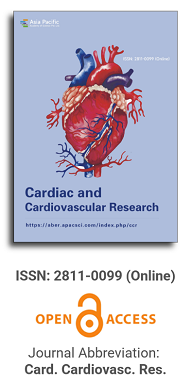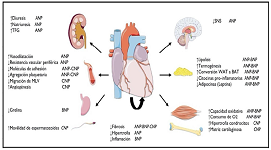
Asia Pacific Academy of Science Pte. Ltd. (APACSCI) specializes in international journal publishing. APACSCI adopts the open access publishing model and provides an important communication bridge for academic groups whose interest fields include engineering, technology, medicine, computer, mathematics, agriculture and forestry, and environment.

Gender approach in cardiac rehabilitation
Vol 3, Issue 2, 2022
Download PDF
Abstract
Introduction: cardiovascular disease in women is underestimated as a health problem. Among the therapeutic options is cardiac rehabilitation, which contributes to the reduction of morbimortality and hospitalization in both genders. Objective: to evaluate the initial behavior and results of a cardiac rehabilitation program in patients attended in the Cardiac Rehabilitation department of the Cardiology service of the General Teaching Hospital "Dr. Agostinho Neto", Guantánamo, during the period 2015–2019. Method: a descriptive, prospective and longitudinal study was carried out. The universe was constituted by 667 patients incorporated to the Cardiac Rehabilitation Program. Risk factors, ergometric parameters given by exercise time, heart rate, blood pressure and functional class were studied. A rehabilitation program was applied that included physical-aerobic and resistance exercises, ergometric tests and serum lipids at the beginning and at 6 months. Results: there is a different risk profile between both genders, obesity is the most prevalent risk factor in the female gender (62.9%) and active smoking in the male gender (78.0%). The improvement of physical capacity was greater in men than in women. The parameters used to improve women's participation and adherence to the program are presented. Conclusions: women have great barriers for incorporation to cardiac rehabilitation programs. It is necessary to provide them with information on the benefits to improve access and permanence in the program.
Keywords
References
- Townsend N, Wilson L, Bhatnagar P, Wickramasinghe K, Rayner M, Nichols M. Cardiovascular disease in Europe 2016: an epidemiological update. European Heart Journal. 2016; 37(42): 3232-3245. doi: 10.1093/eurheartj/ehw334
- Directorate of Medical Records and Health Statistics. Health Statistical Yearbook 2018 (Spanish). Havana: Ministry of Public Health; 2019.
- Martinez CM. Chapter 73. Cardiovascular health. In: Differences between men and women in the incidence of heart disease. Madrid; 2017. pp. 637-642.
- United Nations Children’s Fund. Communication, childhood and adolescence: Guidelines for journalists, 1st ed. CODAJIC; 2017.
- Esquenazi Borrego A. Rosales Vázquez S, Velarde Hernández Y. Gender Inequality Index in Cuba: a territorial approach. Rev Est Desar Soc: Cuba and Latin America. 2017; 5(2): 108-129.
- Perelman J, Fernandes A, Mateus C. Gender Disparities in Health and Healthcare: Results from the Portuguese National Health Interview Survey. Cuad Saúde Púb. 2017; 28(12).
- Campos-Serna J, Ronda-Pérez E, Lucía Artazcoz L, Benavides FG. Gender inequalities in occupational health in Spain. Gac Sanit. 2017; 26(4).
- Maffei S, Guiducci L, Cugusi L, et al. Women-specific predictors of cardiovascular disease risk new paradigms. Int J Cardiol. 2019; 286: 1907.
- Lee JJ, Cook-Wiens G, Johnson BD, et al. Age at menarche and risk of cardiovascular disease outcomes: findings from the National Heart LungandBloodInstitute-sponsored Women’s Ischemia Syndrome Evaluation. J Am Heart Assoc. 2019; 8(12): e012406.
- Aggarwal NR, Patel HN, Mehta LS, et al. Sex differences in ischemic heart disease: Advances, obstacles, and next steps. Circ Cardiovasc. 2018; 11(2): e004437.
- Supervía M, Medina-Inijosa JR, Yeung C, et al. Cardiac rehabilitation for women: A systematic review of barriers and solutions. Mayo Clin Proc. 2017; 92(4): 565-577. doi: 10.1016/j.mayocp.2017.01.002
- Argentine Society of Cardiology. Argentine Consensus on Cardiovascular Rehabilitation. Rev Arg Cardiol. 2019; 87(3): 58.
- Sabo D. Understanding men’s health. A relational and gender-sensitive approach. Harvard: PAHO; 2000.
- Mehta LS, Beckie TM, DeVon HA, et al. Acute Myocardial Infarction in Women: a scientific statement from the American heart association. Circulation. 2016; 133(9): 916-947.
- Anderson L, Thompson DR, Oldridge N, et al. Exercise-based cardiac rehabilitation for coronary heart disease. Cochrane Database Syst Rev. 2016; 2016(1): CD001800. doi: 10.1002/14651858.CD00180 0.pub3
- Garcia M, Mulvagh SL, Bairey Merz CN, et al. Cardiovascular Disease in Women Clinical Perspectives. Review. Circ Res. 2016; 118: 1273-1293. doi: 10.1161/CIRCRESAHA.116. 307547
- Yancy CW, Jessup M, Bozkurt B, et al. 2013 ACCF/AHA Guideline for the Management of Heart Failure: A Report of the American College of Cardiology Foundation/American Heart Association Task Force on Practice Guidelines. Circulation. 2013; 62(16): e147-239. doi: 10.1016/j.jacc.2013.05.019
- Molina DI, Chacón JA, Esparza AS, Botero SM. Depression and cardiovascular risk in women. Rev Colom Cardiol. 2016; 23(3): 159-252. doi: 10.1016/j.rccar.2015.11.004
- Gaalema DE, Savage PD, Jason R, et al. Patient Characteristics predictive of Cardiac Rehabilitation Adherence. J Cardiopulm Reh Prev. 2017; 37(2): 103-110.
- Warburton DE, Bredin SS. Reflections on physical activity and health: what should we recommend? Can J Cardiol. 2016; 32: 495-504.
- Cuellar Gallardo A, Gómez García Y, CastroTorres Y, et al. Cardiovascular rehabilitation in patients with ST-segment elevation acute myocardial infarction and percutaneous coronary intervention. CorSalud. 2019; 11(4): 278-286.
- Rivas Pérez A, Vélez Salas A, Dalmau González-Gallarza R, et al. Cardiac rehabilitation in young women: Does it adapt to their needs? Rev Esp Cardiol. 2017; 70(Suppl 1): 271.
- Prado Díaz S del, Montoro López M, Dalmau González-Gallarza R, et al. Benefits of cardiac rehabilitation in women after acute coronary syndrome. Rev Esp Cardiol. 2015; 68(Suppl 1): 1119.
- Piché ME, Poirier P, Lemieux I, Deprés JP. Overview of epidemiology and contribution of obesity and body fat distribution to cardiovascular disease: an update. Prog Cardiovasc Dis. 2017; 61: 103-113.
- Lee JJ, Pedley A, Hoffman U, et al. Visceral and intrahepatic fat are associated with cardiometabolic risk factors above other ectopic fat depots: the Framingham Heart Study. Am J Med. 2018; 131: 684-692. doi: 10.1016/j.amjmed.2018.02.002
- Quiros Fallas R. Update on cardiovascular risk factors. Rev Méd Sinergia. 2017; 2(1): 3-7.
- Puentes Valle D, Rodríguez Pérez LA, Pupo Ávila NL, Sit Pacheco R. The munticomponent group treatment: an effective method against smoking. Rev Cubana Salud Púb. 2019; 42(2): e1288.
- Smith PH, Kasza KA, Hyland A, et al. Gender differences in medication use and cigarette smoking cessation: results from the international Tobacco control four country. Nicotine ton res Off. J Soc Res Nicotine Tob. 2015; 17(4): 463-472.
- Moreno Hernández M, Gonzalvo Ortega M, Olague Baño C, et al. Effect of cardiac rehabilitation on improving exercise capacity. Rev Clin Esp. 2018; 218: 905.
- Santiago de Araújo Pio C, Marzolini S, Pakosh M, Grace SL. Effect of Cardiac Rehabilitation Dose on Mortality and Morbidity: A Systematic Review and Meta-regression Analysis. Mayo Clin Proc. 2017; 92(11): 1644-1659.
- Asbury EA, Slattery C, Grant A, et al. Cardiac rehabilitation for the treatment of women with chest pain and normal coronary arteries. Menopause. 2008; 15(3): 454-460.
- Darren ER, Warburton DE, Bredin SS. Reflections on physical activity and health: what should we recommend? Can J Cardiol. 2016; 32(4): 495-504. doi: 10.1016/j.cjca.2016.01.024
- Sanchez-Delgado JC, Betty LM, Angarita Fonseca A, et al. Reliability of the barriers scale for cardiac rehabilitation. Rev Colom Cardiol. 2018; 25(1): 84-91.
- Ros Sanchez T, Lindon Cerezuela B. The experience of empowerment in women over 65 years old. A qualitative study. Gerokomos. 2018; 29(1): 3-8.
- National Ministry of Health. Manual for the care of people with chronic noncommunicable diseases: comprehensive management at the first level of care. Geneva: WHO; 2017.
- Anchique CV, Fernández RO, Zeballos C. Cardiovascular rehabilitation in women. Rev Colom Cardiol. 2018; 25(S1): 99-105.
Supporting Agencies
Copyright (c) 2022 Varinia Montero-Vega, Rolando Carbonell-Riera

This work is licensed under a Creative Commons Attribution 4.0 International License.

This site is licensed under a Creative Commons Attribution 4.0 International License (CC BY 4.0).

Prof. Prakash Deedwania
University of California,
San Francisco, United States




